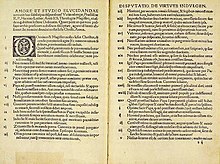Gott der Herr ist Sonn und Schild, BWV 79
|
Gott der Herr ist Sonn und Schild BWV 79 |
|
|---|---|
| Chorale cantata by J. S. Bach | |

Luther's Ninety-Five Theses, beginning the Reformation
|
|
| Occasion | Reformation Day |
| Performed | 31 October 1725: Leipzig |
| Movements | 6 |
| Cantata text | anonymous |
| Bible text | |
| Chorale |
|
| Vocal | SATB choir and soloists |
| Instrumental |
|
Gott der Herr ist Sonn und Schild (God the Lord is sun and shield),BWV 79, is a church cantata by Johann Sebastian Bach. He composed it in Leipzig in 1725, his third year as Thomaskantor, for Reformation Day and led the first performance on 31 October 1725.
The text was written by an unknown poet, who did not refer to the prescribed readings for the day. Bach began the libretto for the feast with a quotation from Psalm 84 and included two hymn stanzas, the first from Martin Rinckart's "Nun danket alle Gott", associated with Reformation Day in Leipzig, as movement 3, and as the last movement the final stanza of Ludwig Helmbold's "Nun laßt uns Gott dem Herren". Bach composed a work of "festive magnificence", structured in six movements, with an aria following the opening chorus, a pair of recitative and duet following the first chorale. He scored the work for three vocal soloists, a four-part choir, and a Baroque instrumental ensemble of two horns, timpani, two transverse flutes (added for a later performance), two oboes, strings and continuo. He achieved a unity within the structure by using the horns not only in the opening but also as obbligato instruments in the two chorales, the first time even playing the same motifs.
Bach performed the cantata again, probably in 1730. He later reworked the music of the opening chorus and a duet again in his Missa in G major, BWV 236, and the music of an alto aria in his Missa in A major, BWV 234.
...
Wikipedia
